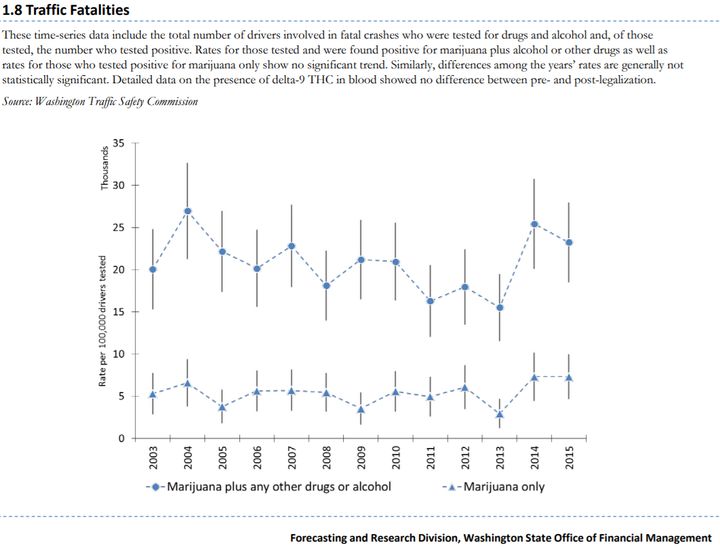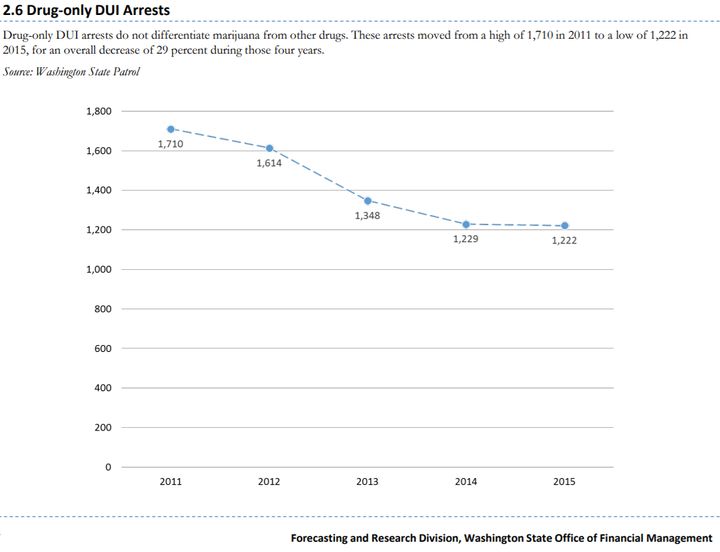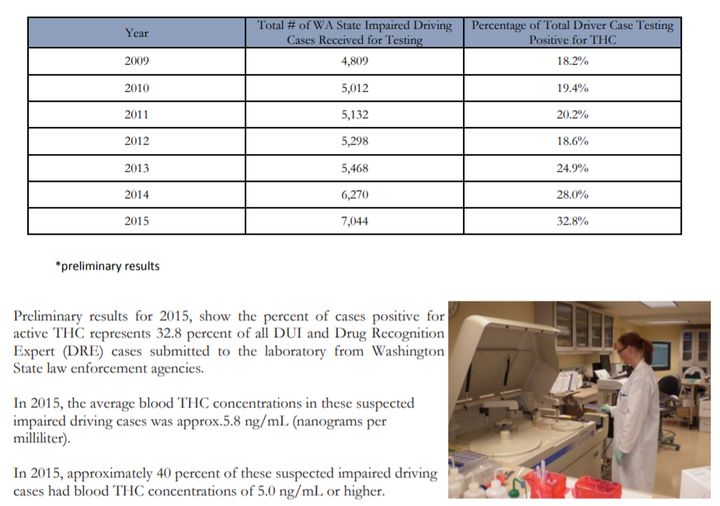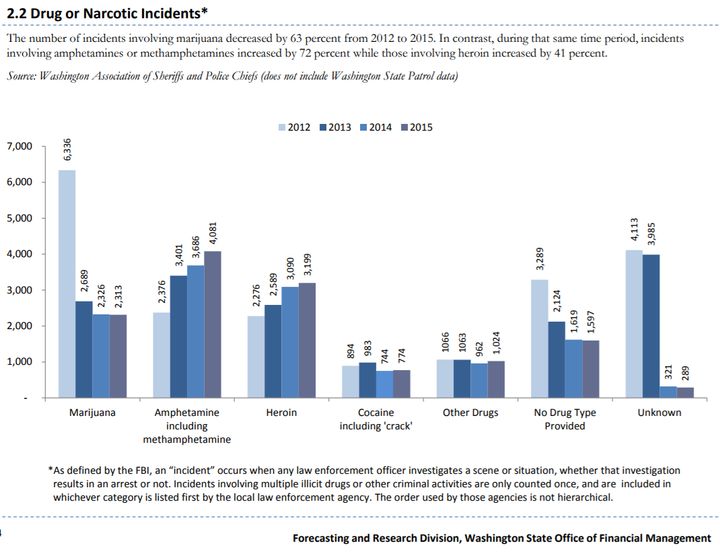As we approach the fifth anniversary of the first two states to legalize marijuana – Washington and Colorado – it’s instructive for other states to learn from their example.
In March 2017, Washington’s Office of Financial Management produced a PowerPoint presentation entitled, “Monitoring Impacts of Recreational Marijuana Legalization.”
From that presentation are charts that contradict the predictions of failure from opponents of Initiative 502, the ballot question in 2012 that legalized marijuana in Washington.
In Part I, I broke down the biggest fears offered about the effect of marijuana legalization on children’s use. In Part II, I showed you how legalization has affected children who do use marijuana. In this Part III, I’ll show you what effect marijuana legalization had on traffic safety. Finally, in Part IV, I’ll show you how much marijuana tax revenue the state of Washington has earned.
Legalization Did Not Create Stoned Mayhem on the Freeways
Every state that has addressed the issue of marijuana legalization has faced dire predictions that it would unleash upon our roadways a legion of stoned drivers who would leave a trail of traffic deaths in their wake.

It’s almost as if legalization didn’t invent cars and marijuana.
The data, however, show “no significant trend” when you look at the positive rates for THC found in the bodies of dead drivers, alone or in combination with other drugs. The differences found from year to year “are not generally statistically significant.”
Recent studies have corroborated the fact that the detection of THC in the blood of a driver shows they are not any more statistically-likely to get into a crash than a sober driver. Legalization does not make a state’s roadways any more dangerous. That’s why “detailed data on the presence of delta-9 THC in blood showed no difference between pre- and post-legalization.”
Legalization Did Not Create An Increase In “Green DUIs”
A twist in the opposition to Washington’s legalization initiative was that some people whose marijuana smoking would no longer be criminal were among the opposition. The initiative’s arbitrary, unscientific, and unjust DUI standard mandated that anyone whose blood tests at greater than 5 nanograms of THC per milliliter provides automatic evidence of guilt. This per se DUID statute, they argued, would lead to a massive increase of marijuana consumers being busted for DUI by police who could no longer bust them for possession.

Washington’s per se DUID law has led to fewer green DUIs than prohibition’s “I smell pot” excuse for cops to harass people.
Figures for marijuana DUI arrests alone aren’t available. But the data for “drug-only DUIs” - the DUIs that exclude alcohol - have shown drug-only DUIs, including marijuana, experienced “an overall decrease of 29 percent during those four years” before and after legalization.
There have been more blood tests being taken by the Washington State Patrol, which has forwarded to the state toxicology labs many more blood samples that have tested positive for THC since legalization. In 2009, about 4,800 cases were submitted, with about 18 percent that were positive for THC. In 2015, there were about 7,000 cases with almost a third of them positive.

More drivers got tested for THC, but fewer of them were “over the limit.”
At first glance, opponents would argue these data show that there have been more THC-positive drivers busted by police. If 32.8 percent of 7,044 toxicology tests came back positive for THC, that’s 2,310 THC-positives.
That’s positive for any THC, however, and since I-502 passed, only THC readings above 5 nanograms are considered automatically guilty. Only “40 percent of these suspected impaired driving cases had blood THC concentrations of 5.0 ng/mL or higher,” or roughly 924 automatic DUIs.
Before I-502 created a per se 5 nanogram THC limit, however, the law considered everybody who was testing positive for THC as a potential DUI charge. So, in 2011, of 5,132 tests there were 20.2 percent THC-positive, or 1,036 potential DUIs.
Even the level of THC found in suspected DUI drivers’ blood is decreasing. “In 2015,” the latest Washington State Patrol report tells us, “the average blood THC concentrations in these suspected impaired driving cases was approx. 5.8 ng/mL.” In the 2014 report, that average was “approximately 6.7 ng/mL.”
The 5 ng/mL limit is still wrong. The 924 estimated drivers who’d presumably earned automatic DUI convictions had their right to argue any evidence of their innocence unjustly withheld from them by that unscientific limit.
However, one cannot argue there has been “a massive increase in green DUI convictions.”
Legalization Reallocated Police Resources to Prosecute Hard Drugs
One prediction from supporters of marijuana legalization in 2012 was that freeing up police from the task of pursuing cases against people involving marijuana would allow them to reallocate those resources toward pursuit of drugs more harmful to society.

Well, what should we do now that we can’t go after all the marijuana smokers?
Indeed, immediately following the legalization of marijuana, incidents of police interactions with citizens involving marijuana dropped about 57 percent. At the same time, incidents involving amphetamines and heroin have steadily increased.
Opponents might argue that shows police had to respond to more incidents involving hard drugs because legalization of marijuana led to more overall drug use.
The data don’t support such an assertion. In the 2010-2011 edition of state drug use statistics from the National Survey on Drug Use and Health, Washington had 4.23 percent of its population 12 and older that admitted “Illicit Drug Use Other Than Marijuana in the Past Month.” In the 2011-2012 edition, the rate was 3.89 percent.
Following marijuana legalization, the 2012-2013 edition shows a rate of 4.02 percent, followed by the 2013-2014 edition’s rate of 3.87 percent.
Interestingly, the federal government no longer lists the “Illicit Drug Use Other Than Marijuana in the Past Month” in the latest (2014-2015) edition of the state statistics.
It’s not the first time the government has sandbagged a statistic that paints the war on marijuana in a bad light. In 2008, the DEA stopped reporting on how much of the cannabis they were eradicating was actually wild ditchweed (98 percent) that wouldn’t get anybody high, after NORML kept pointing out how much money they were wasting eradicating feral hemp.
Continue on to Part IV where I tally up all the money Washington has earned in taxes from legalized marijuana...
